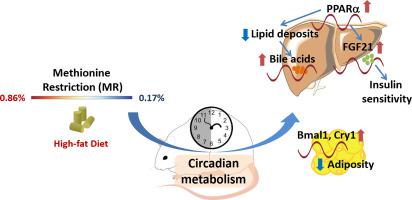Biochimica et Biophysica Acta (BBA) - Molecular Basis of Disease ( IF 4.2 ) Pub Date : 2020-07-31 , DOI: 10.1016/j.bbadis.2020.165908 Luanfeng Wang 1 , Bo Ren 1 , Qian Zhang 1 , Chuanqi Chu 1 , Zhenting Zhao 1 , Jianbin Wu 1 , Weiyang Zhao 2 , Zhigang Liu 3 , Xuebo Liu 1

|
Circadian misalignment induced by a high-fat diet (HFD) increases the risk of metabolic diseases. Methionine restriction (MR) is known to have the potential of alleviating obesity by improving insulin sensitivity. However, the role of the circadian clock in mediating the effects of MR on obesity-related metabolic disorders remains unclear. Ten-week-old male C57BL/6 J mice were fed with a low-fat diet (LFD) or a HFD for 4 wk., followed with a full diet (0.86% methionine, w/w) or a methionine-restricted diet (0.17% methionine, w/w) for 8 wk. Our results showed that MR attenuated insulin resistance triggered by HFD, especially at ZT12. Moreover, MR led to a time-specific enhancement of the expression of FGF21 and activated the AMPK/PGC-1α signaling. Notably, MR upregulated the cyclical levels of cholic acid (CA) and chenodeoxycholic acid (CDCA), and downregulated the cyclical level of deoxycholic acid (DCA) in the dark phase. MR restored the HFD-disrupted cyclical fluctuations of lipidolysis genes and BAs synthetic genes and improved the circulating lipid profile. Also, MR improved the expressions of clock-controlled genes (CCGs) in the liver and the brown adipose tissue throughout one day. In conclusion, MR exhibited the lipid-lowering effects on HFD-induced obesity and restored the diurnal metabolism of lipids and BAs, which could be partly explained by improving the expression of CCGs. These findings suggested that MR could be a potential nutritional intervention for attenuating obesity-induced metabolic misalignment.
中文翻译:

蛋氨酸的限制减轻了高脂饮食引起的肥胖:涉及脂质和胆汁酸的昼夜代谢。
由高脂饮食(HFD)引起的昼夜节律紊乱会增加发生代谢性疾病的风险。已知蛋氨酸限制(MR)具有通过改善胰岛素敏感性来减轻肥胖的潜力。然而,生物钟在介导MR对肥胖相关的代谢紊乱的影响中的作用尚不清楚。十周大的雄性C57BL / 6 J小鼠接受低脂饮食(LFD)或HFD喂养4周,然后进行全饮食(0.86%蛋氨酸,w / w)或蛋氨酸限制饮食(0.17%蛋氨酸,w / w)8周。我们的结果表明,MR减弱了HFD触发的胰岛素抵抗,尤其是在ZT12处。此外,MR导致FGF21表达的时间特异性增强,并激活AMPK /PGC-1α信号传导。值得注意的是,MR在黑暗阶段上调了胆酸(CA)和鹅去氧胆酸(CDCA)的循环水平,并下调了脱氧胆酸(DCA)的循环水平。MR恢复了HFD破坏的脂解基因和BAs合成基因的周期性波动,并改善了循环脂质谱。此外,MR整天改善了肝脏和棕色脂肪组织中时钟控制基因(CCG)的表达。总之,MR对HFD引起的肥胖具有降脂作用,并恢复了脂质和BAs的昼夜代谢,可以通过改善CCG的表达来部分解释这一点。这些发现表明,MR可能是减轻肥胖引起的代谢失调的潜在营养干预措施。









































 京公网安备 11010802027423号
京公网安备 11010802027423号